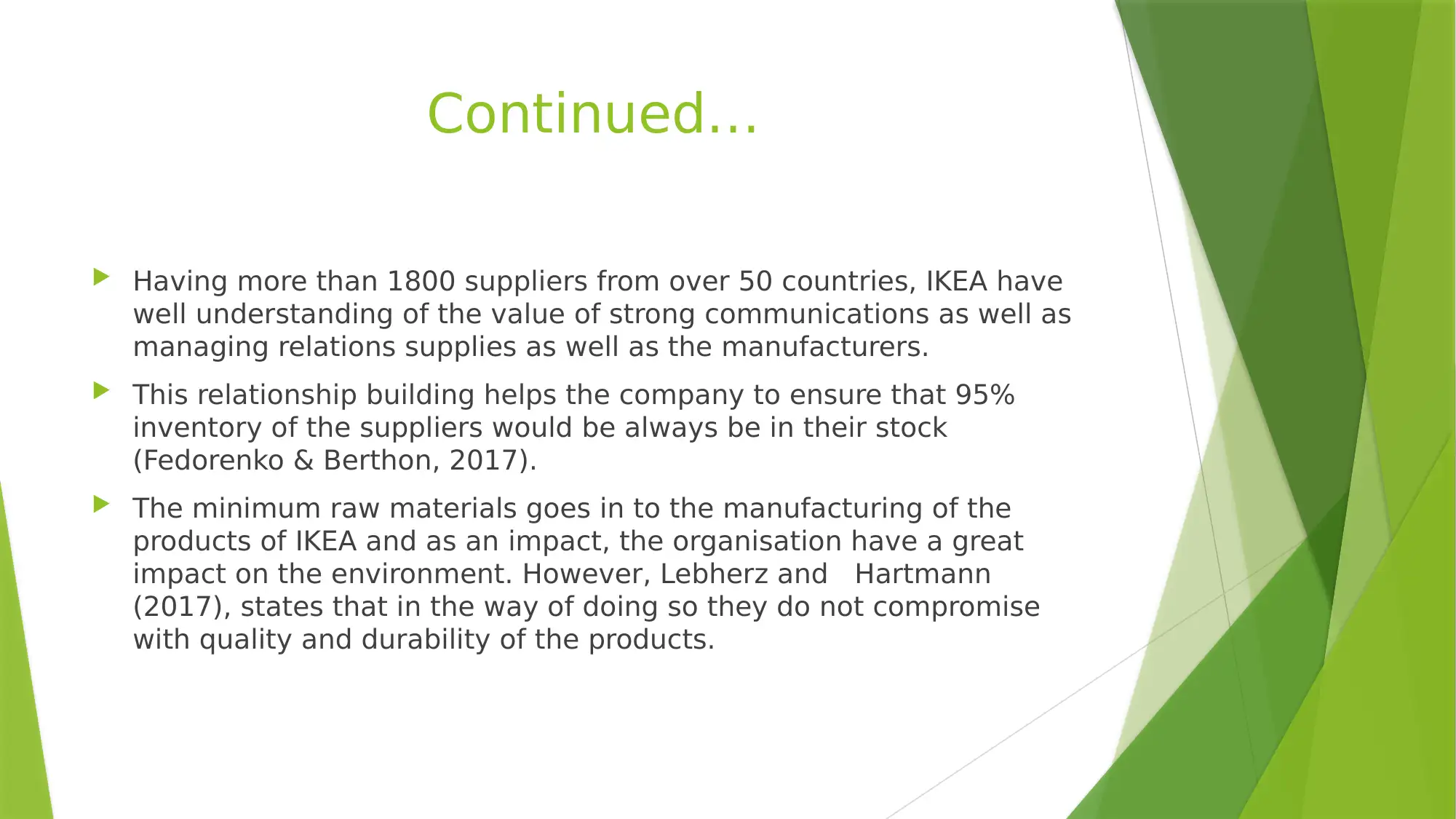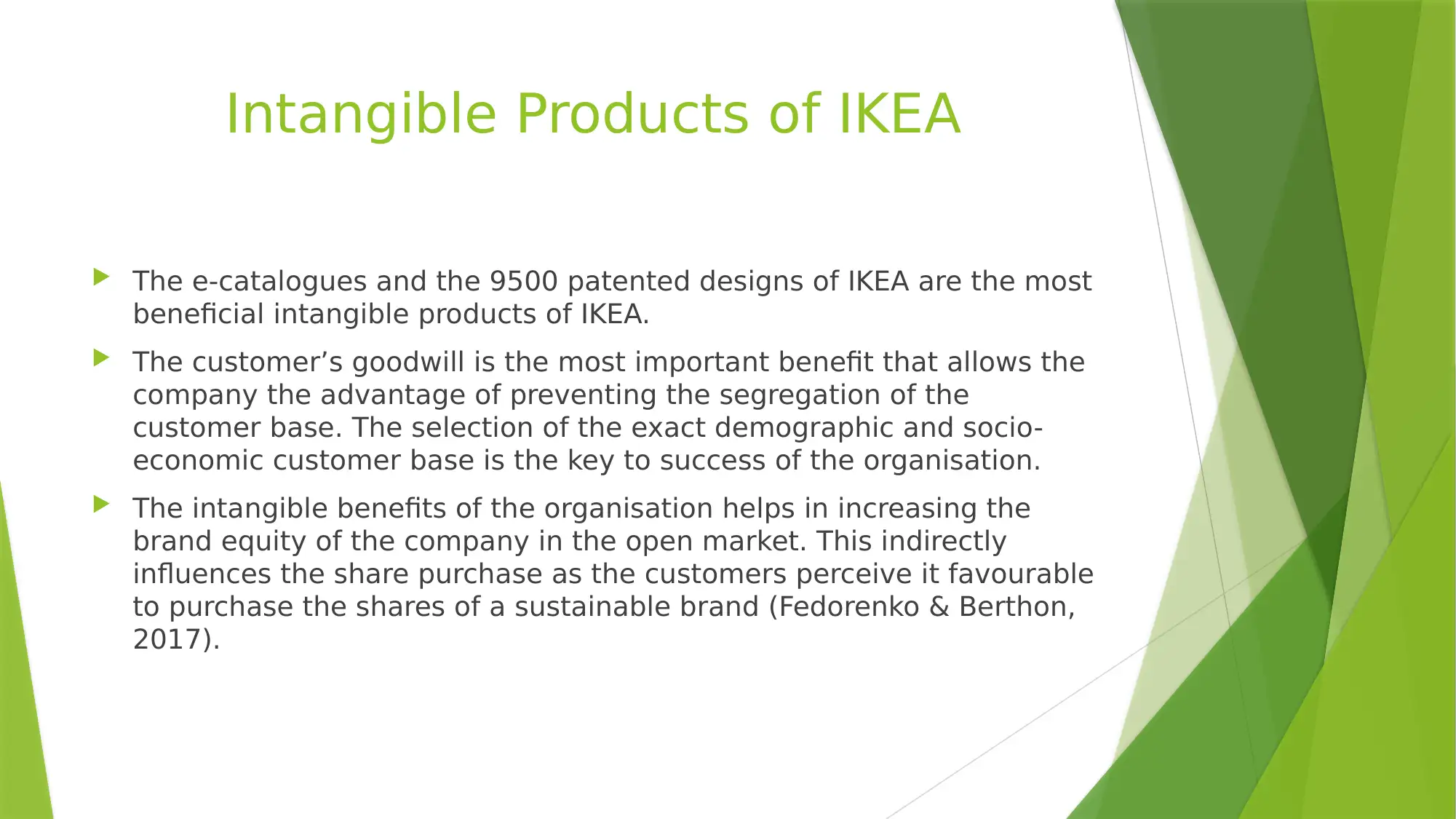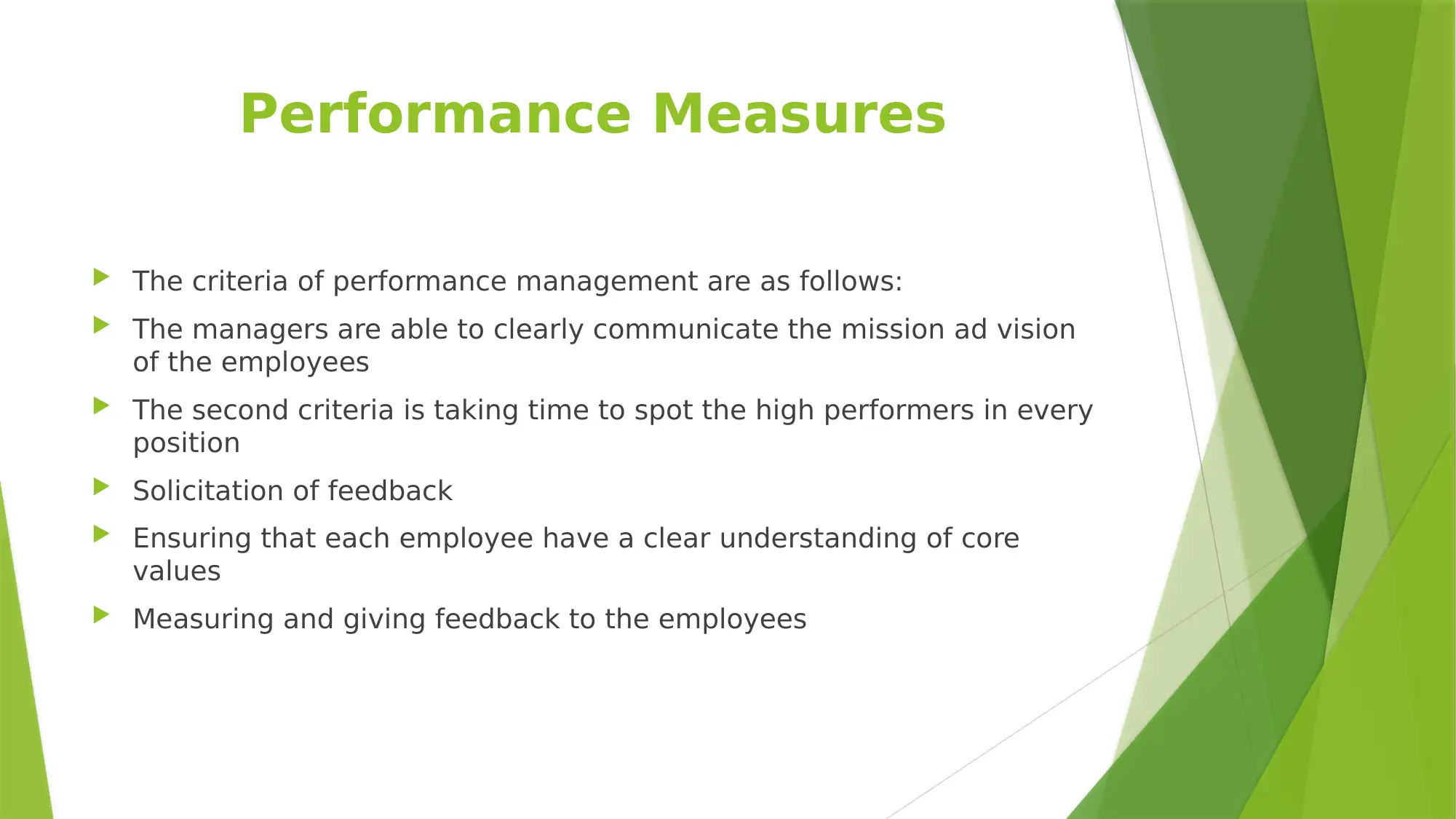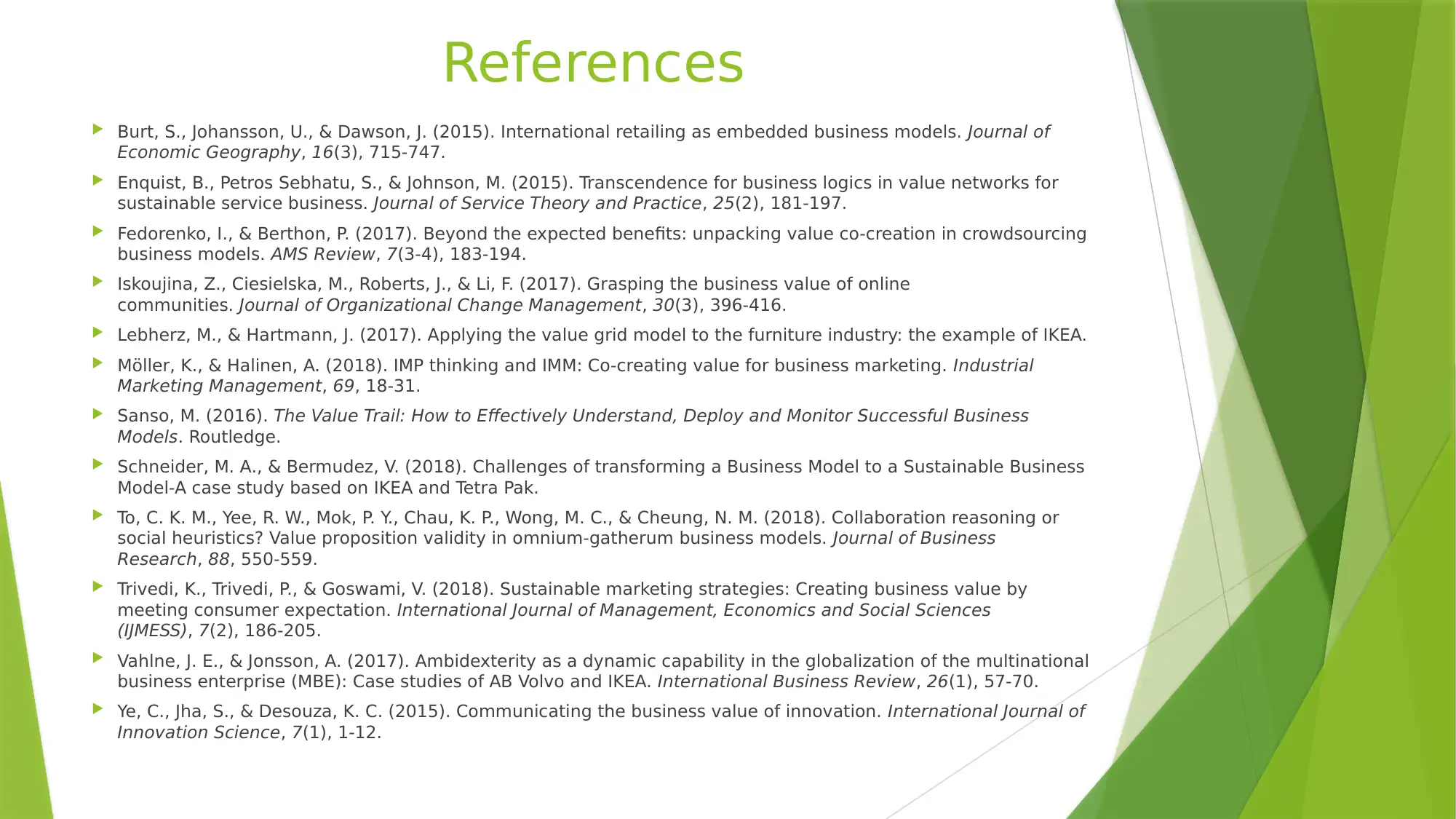Operations Management Analysis: Challenges and Solutions for IKEA
VerifiedAdded on 2021/09/17
|10
|1230
|37
Report
AI Summary
This report provides an in-depth analysis of IKEA's operations management, focusing on its strategies, challenges, and proposed solutions. It begins by highlighting IKEA's marketing approach, emphasizing cost leadership and unique designs tailored to its target customers. The report then assesses IKEA's overall strategy, including its value chain, manufacturing locations, and social initiatives like collaborations with UNICEF and sustainable forestry programs. It also examines IKEA's intangible products, such as e-catalogues and patented designs, and how these contribute to customer goodwill and brand equity. Furthermore, the report analyzes IKEA's customer-based pricing strategies and performance management criteria. Finally, it offers recommendations for improving performance management, including clear job descriptions, performance evaluation forms, self-review processes, and skills surveys.

OPERATIONS
MANAGEMENT:
SOLUTIONS TO
BUSINESS
CHALLENGES
Company Selected:
IKEA
MANAGEMENT:
SOLUTIONS TO
BUSINESS
CHALLENGES
Company Selected:
IKEA
Paraphrase This Document
Need a fresh take? Get an instant paraphrase of this document with our AI Paraphraser

Marketing of IKEA
The cost leadership as well as the unique Swedish designs of the IKEA
provide the young customers (primary target customers) with
excellent value
Based on lifestyle changes, the designers and manufacturers have
improvised various new furniture categories like flexible furniture,
interchangeable kitchen as well as living room furniture and so on
(Möller & Halinen, 2018).
The customer base which provides most active response regarding
the products, have the strongest connection with the brand (Sanso,
2016).
The cost leadership as well as the unique Swedish designs of the IKEA
provide the young customers (primary target customers) with
excellent value
Based on lifestyle changes, the designers and manufacturers have
improvised various new furniture categories like flexible furniture,
interchangeable kitchen as well as living room furniture and so on
(Möller & Halinen, 2018).
The customer base which provides most active response regarding
the products, have the strongest connection with the brand (Sanso,
2016).

Assessment of IKEA’s strategy
Economic value is rendered to the IKEA value chain by locating most
of the manufacturing units of the company over China, SE Asia or
Eastern Europe. As per To et al. (2018), this saves money over the HR
and cost of raw materials
The IKEA have teamed up with the UNICEF to drive out malnutrition,
infant diseases and improvement of literacy. An estimated 100 million
children receives the benefits of IKEA social initiative.
The IKEA supports and actively participates in the initiative of
sustained forestry (Schneider & Bermudez, 2018). The Long term goal
of the organisation is to procure entire wood in the range of IKEA from
the forests that are certified as well as managed responsibly.
Economic value is rendered to the IKEA value chain by locating most
of the manufacturing units of the company over China, SE Asia or
Eastern Europe. As per To et al. (2018), this saves money over the HR
and cost of raw materials
The IKEA have teamed up with the UNICEF to drive out malnutrition,
infant diseases and improvement of literacy. An estimated 100 million
children receives the benefits of IKEA social initiative.
The IKEA supports and actively participates in the initiative of
sustained forestry (Schneider & Bermudez, 2018). The Long term goal
of the organisation is to procure entire wood in the range of IKEA from
the forests that are certified as well as managed responsibly.
⊘ This is a preview!⊘
Do you want full access?
Subscribe today to unlock all pages.

Trusted by 1+ million students worldwide

Continued…
Having more than 1800 suppliers from over 50 countries, IKEA have
well understanding of the value of strong communications as well as
managing relations supplies as well as the manufacturers.
This relationship building helps the company to ensure that 95%
inventory of the suppliers would be always be in their stock
(Fedorenko & Berthon, 2017).
The minimum raw materials goes in to the manufacturing of the
products of IKEA and as an impact, the organisation have a great
impact on the environment. However, Lebherz and Hartmann
(2017), states that in the way of doing so they do not compromise
with quality and durability of the products.
Having more than 1800 suppliers from over 50 countries, IKEA have
well understanding of the value of strong communications as well as
managing relations supplies as well as the manufacturers.
This relationship building helps the company to ensure that 95%
inventory of the suppliers would be always be in their stock
(Fedorenko & Berthon, 2017).
The minimum raw materials goes in to the manufacturing of the
products of IKEA and as an impact, the organisation have a great
impact on the environment. However, Lebherz and Hartmann
(2017), states that in the way of doing so they do not compromise
with quality and durability of the products.
Paraphrase This Document
Need a fresh take? Get an instant paraphrase of this document with our AI Paraphraser

Intangible Products of IKEA
The e-catalogues and the 9500 patented designs of IKEA are the most
beneficial intangible products of IKEA.
The customer’s goodwill is the most important benefit that allows the
company the advantage of preventing the segregation of the
customer base. The selection of the exact demographic and socio-
economic customer base is the key to success of the organisation.
The intangible benefits of the organisation helps in increasing the
brand equity of the company in the open market. This indirectly
influences the share purchase as the customers perceive it favourable
to purchase the shares of a sustainable brand (Fedorenko & Berthon,
2017).
The e-catalogues and the 9500 patented designs of IKEA are the most
beneficial intangible products of IKEA.
The customer’s goodwill is the most important benefit that allows the
company the advantage of preventing the segregation of the
customer base. The selection of the exact demographic and socio-
economic customer base is the key to success of the organisation.
The intangible benefits of the organisation helps in increasing the
brand equity of the company in the open market. This indirectly
influences the share purchase as the customers perceive it favourable
to purchase the shares of a sustainable brand (Fedorenko & Berthon,
2017).

Customers
One of the most feasible advantages of the customer based pricing is
framing of positive perception of the customers. As an outcome of
offering a variety in the price range to the customers, the customers
seem to gravitate towards the middle of the range (Burt, Johansson &
Dawson, 2015).
The price methodology exhibits that keeping all others equal within a
market with high competition, the price per unit against one single
good or different trade related items like as labour and also liquid
assets would be varying so far that approaches one point where it
sediments at one certain point where the quantity demanded at a
certain current price would equal to the quantity supplied at one
current price.
One of the most feasible advantages of the customer based pricing is
framing of positive perception of the customers. As an outcome of
offering a variety in the price range to the customers, the customers
seem to gravitate towards the middle of the range (Burt, Johansson &
Dawson, 2015).
The price methodology exhibits that keeping all others equal within a
market with high competition, the price per unit against one single
good or different trade related items like as labour and also liquid
assets would be varying so far that approaches one point where it
sediments at one certain point where the quantity demanded at a
certain current price would equal to the quantity supplied at one
current price.
⊘ This is a preview!⊘
Do you want full access?
Subscribe today to unlock all pages.

Trusted by 1+ million students worldwide

Performance Measures
The criteria of performance management are as follows:
The managers are able to clearly communicate the mission ad vision
of the employees
The second criteria is taking time to spot the high performers in every
position
Solicitation of feedback
Ensuring that each employee have a clear understanding of core
values
Measuring and giving feedback to the employees
The criteria of performance management are as follows:
The managers are able to clearly communicate the mission ad vision
of the employees
The second criteria is taking time to spot the high performers in every
position
Solicitation of feedback
Ensuring that each employee have a clear understanding of core
values
Measuring and giving feedback to the employees
Paraphrase This Document
Need a fresh take? Get an instant paraphrase of this document with our AI Paraphraser

Recommendation
Firstly, during the hiring process, the candidates should be provided a
clear overview of the involvement that is expected from them along
with providing a clear understanding of the job description.
In order to ensure better performance management, the
management should define a rating scale and have the provision for
a performance evaluation form. They should also make the process of
self-review compulsory for the employees.
The third strategy should be the survey of the employees’ skills and
aligning further training with the operating goals of the organisation.
Firstly, during the hiring process, the candidates should be provided a
clear overview of the involvement that is expected from them along
with providing a clear understanding of the job description.
In order to ensure better performance management, the
management should define a rating scale and have the provision for
a performance evaluation form. They should also make the process of
self-review compulsory for the employees.
The third strategy should be the survey of the employees’ skills and
aligning further training with the operating goals of the organisation.

References
Burt, S., Johansson, U., & Dawson, J. (2015). International retailing as embedded business models. Journal of
Economic Geography, 16(3), 715-747.
Enquist, B., Petros Sebhatu, S., & Johnson, M. (2015). Transcendence for business logics in value networks for
sustainable service business. Journal of Service Theory and Practice, 25(2), 181-197.
Fedorenko, I., & Berthon, P. (2017). Beyond the expected benefits: unpacking value co-creation in crowdsourcing
business models. AMS Review, 7(3-4), 183-194.
Iskoujina, Z., Ciesielska, M., Roberts, J., & Li, F. (2017). Grasping the business value of online
communities. Journal of Organizational Change Management, 30(3), 396-416.
Lebherz, M., & Hartmann, J. (2017). Applying the value grid model to the furniture industry: the example of IKEA.
Möller, K., & Halinen, A. (2018). IMP thinking and IMM: Co-creating value for business marketing. Industrial
Marketing Management, 69, 18-31.
Sanso, M. (2016). The Value Trail: How to Effectively Understand, Deploy and Monitor Successful Business
Models. Routledge.
Schneider, M. A., & Bermudez, V. (2018). Challenges of transforming a Business Model to a Sustainable Business
Model-A case study based on IKEA and Tetra Pak.
To, C. K. M., Yee, R. W., Mok, P. Y., Chau, K. P., Wong, M. C., & Cheung, N. M. (2018). Collaboration reasoning or
social heuristics? Value proposition validity in omnium-gatherum business models. Journal of Business
Research, 88, 550-559.
Trivedi, K., Trivedi, P., & Goswami, V. (2018). Sustainable marketing strategies: Creating business value by
meeting consumer expectation. International Journal of Management, Economics and Social Sciences
(IJMESS), 7(2), 186-205.
Vahlne, J. E., & Jonsson, A. (2017). Ambidexterity as a dynamic capability in the globalization of the multinational
business enterprise (MBE): Case studies of AB Volvo and IKEA. International Business Review, 26(1), 57-70.
Ye, C., Jha, S., & Desouza, K. C. (2015). Communicating the business value of innovation. International Journal of
Innovation Science, 7(1), 1-12.
Burt, S., Johansson, U., & Dawson, J. (2015). International retailing as embedded business models. Journal of
Economic Geography, 16(3), 715-747.
Enquist, B., Petros Sebhatu, S., & Johnson, M. (2015). Transcendence for business logics in value networks for
sustainable service business. Journal of Service Theory and Practice, 25(2), 181-197.
Fedorenko, I., & Berthon, P. (2017). Beyond the expected benefits: unpacking value co-creation in crowdsourcing
business models. AMS Review, 7(3-4), 183-194.
Iskoujina, Z., Ciesielska, M., Roberts, J., & Li, F. (2017). Grasping the business value of online
communities. Journal of Organizational Change Management, 30(3), 396-416.
Lebherz, M., & Hartmann, J. (2017). Applying the value grid model to the furniture industry: the example of IKEA.
Möller, K., & Halinen, A. (2018). IMP thinking and IMM: Co-creating value for business marketing. Industrial
Marketing Management, 69, 18-31.
Sanso, M. (2016). The Value Trail: How to Effectively Understand, Deploy and Monitor Successful Business
Models. Routledge.
Schneider, M. A., & Bermudez, V. (2018). Challenges of transforming a Business Model to a Sustainable Business
Model-A case study based on IKEA and Tetra Pak.
To, C. K. M., Yee, R. W., Mok, P. Y., Chau, K. P., Wong, M. C., & Cheung, N. M. (2018). Collaboration reasoning or
social heuristics? Value proposition validity in omnium-gatherum business models. Journal of Business
Research, 88, 550-559.
Trivedi, K., Trivedi, P., & Goswami, V. (2018). Sustainable marketing strategies: Creating business value by
meeting consumer expectation. International Journal of Management, Economics and Social Sciences
(IJMESS), 7(2), 186-205.
Vahlne, J. E., & Jonsson, A. (2017). Ambidexterity as a dynamic capability in the globalization of the multinational
business enterprise (MBE): Case studies of AB Volvo and IKEA. International Business Review, 26(1), 57-70.
Ye, C., Jha, S., & Desouza, K. C. (2015). Communicating the business value of innovation. International Journal of
Innovation Science, 7(1), 1-12.
⊘ This is a preview!⊘
Do you want full access?
Subscribe today to unlock all pages.

Trusted by 1+ million students worldwide

Thank You
1 out of 10
Related Documents
Your All-in-One AI-Powered Toolkit for Academic Success.
+13062052269
info@desklib.com
Available 24*7 on WhatsApp / Email
![[object Object]](/_next/static/media/star-bottom.7253800d.svg)
Unlock your academic potential
Copyright © 2020–2025 A2Z Services. All Rights Reserved. Developed and managed by ZUCOL.




